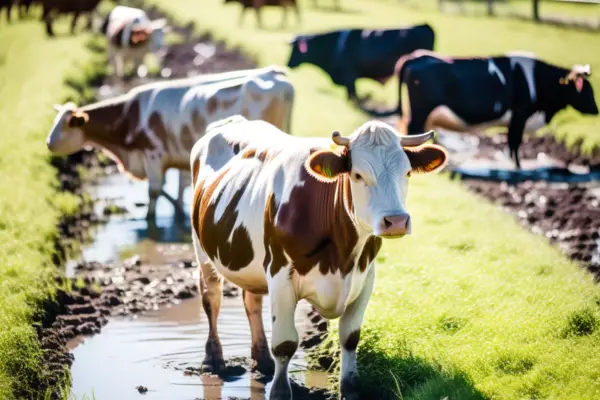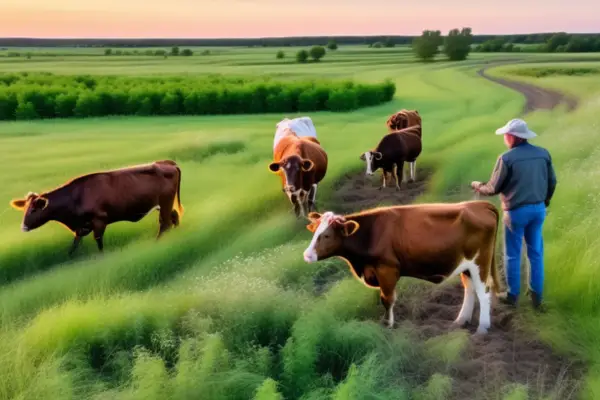Implementing a sustainable grazing system for cattle is essential for each environmental and financial causes. Overgrazing can result in soil erosion, lack of vegetation, diminished biodiversity, and full land degradation over time. Moreover, poor grazing administration generally ends in decrease weight constructive parts for cattle and diminished earnings for ranchers.
Nonetheless, with cautious planning and administration, it’s doable to develop an optimized, regenerative grazing system that improves soil and plant successfully being whereas supporting healthful, productive livestock.
The keys are controlling timing and depth of grazing, selling vegetation restoration durations, and using gadgets like fencing and water stage distribution.
Assess Present Sources
The first step is taking inventory of your present pastures, grasses, water sources, fencing, and one different infrastructure. Stroll the land and make notes on the next:
- Pasture measurement, variety, terrain
- Kinds of present grasses and forages
- Prevalence of desired species to your native local weather and cattle operation
- Areas of overgrazing or weed infestation
- Location of shade, pure windbreaks, and water sources
This evaluation helps inform your grazing performance for land all by diversified seasons whereas figuring out any enhancements wished.

Implement Rotational Grazing
Rotational or managed intensive grazing packages dividing pastures into numerous paddocks that cattle rotate by the use of on a deliberate schedule. Usually, paddocks enable 1-15 days of grazing adopted by 25-90 days of relaxation and regrowth.
Advantages of rotational grazing embody:
- Further even manure distribution, enhancing pure matter and dietary nutritional vitamins in soil
- Longer relaxation durations, permitting crops to regrow stronger roots and leaves
- Elevated grass manufacturing and carrying performance over time
- Bigger administration over timing of grazing primarily based completely on plant progress ranges
To implement rotational grazing, prepare electrical fencing or divide present pastures with everlasting fencing to create paddocks of equal grazing value. The optimum paddock quantity depends upon upon the scale of your operation nonetheless usually ranges from 8 to 12 separate areas. Observe cattle actions utilizing a grazing chart that outlines the rotation schedule and restoration durations for every home.
Enhance Forage Top of the range
Overview the types of present grasses and forages in your pastures. Decide if any modifications should be made to make sure to have productive, resilient species well-suited for grazing in your native local weather and soils. This can increasingly embody:
- Overseeding less-productive areas with improved or native forage species
- Weed administration and administration
- Soil testing and making use of any wished soil amendments like lime or micronutrients
- Planning fertilizer capabilities spherical grazing rotations to keep away from overgrazing lush new progress
- Incorporating legumes like clover into cool-season grasses to cut once more want for nitrogen fertilizers
Greater-quality, diversified forages translate to bigger cattle constructive parts and pasture resilience whereas lowering supplemental feed needs.

Cope with Stocking Charges
Base the variety of cattle grazed on the ultimate productiveness of the land every season, expressed as animal objects per acre. This stocking cost determines in case you are overgrazing or underutilizing accessible forages. Search steering from agricultural extension property to set sustainable stocking charges in your house.
Be ready to handle as wished by having fallback paddocks to maneuver cattle into in intervals of sluggish forage regrowth. Lighter stocking presents crops adequate restoration time between grazing occasions. Make reductions in case you uncover declines in pasture high-quality, uncovered soil, inflow of weeds, or poor cattle widespread each day constructive parts.
Present Adequate Water Sources
Cattle want mounted entry to scrub consuming water. Plan water parts like tanks, troughs, or pure water our our our bodies to fall inside 800 ft of grazing paddocks when doable. Maintain in any case one water present for each 50-75 head of cattle. Area water parts in any case 400 ft aside to advertise even grazing distribution reasonably than concentrated areas surrounding a single present.
Overview location picks yearly and regulate as wished primarily based completely on observations of cattle motion, grazing patterns, and erosion components.
Use Low-Stress Livestock Dealing with
The simplest method cattle are moved between paddocks can have an effect on soil compaction and vegetation trampling if not executed precisely. Implementing low-stress livestock dealing with strategies promotes calmer cattle motion whereas lowering security dangers for each handlers and animals.
Methods embody:
- Clear marking of entrances and exists
- Creating funnel-shaped paddock layouts
- Benefiting from cattle’s pure circling instincts
- Utilizing educated herding canines or horses
- Positioning folks on the as soon as extra to supply stress from behind
Avoid electrical prods or yelling. Swap cattle slowly and quietly in established routes between paddock gates to help soil conservation.
Monitor and Adapt
Persistently monitor your grazing system, forage high-quality, soil successfully being, and cattle physique state of affairs. Keep detailed data that uncover grazing interval and depth inside every home, relaxation durations, rainfall, temperature patterns, and any modifications made.
Overview data and visually research pastures each all by and post-grazing. Any components with diminished plant vigor, uncovered soil, erosion, or poor cattle effectivity alerts changes are wished.
Have the ability to rotate cattle sooner, further in the reduction of stocking charges, reseed naked areas, or present cattle supplemental forage all by extended native climate extremes. A sustainable grazing system should be resilient to seasonal variability.
Closing Phrases;
Implementing these regenerative grazing practices takes dedication nonetheless pays off in further healthful soils, forages, cattle, and elevated ranch profitability over the long run.
Modify and refine primarily based completely on proof to your surroundings whereas specializing in maximizing pasture relaxation durations and soil safety every time doable. With shut administration and monitoring, cattle might very effectively be raised in symbiosis with grassland ecosystems.

